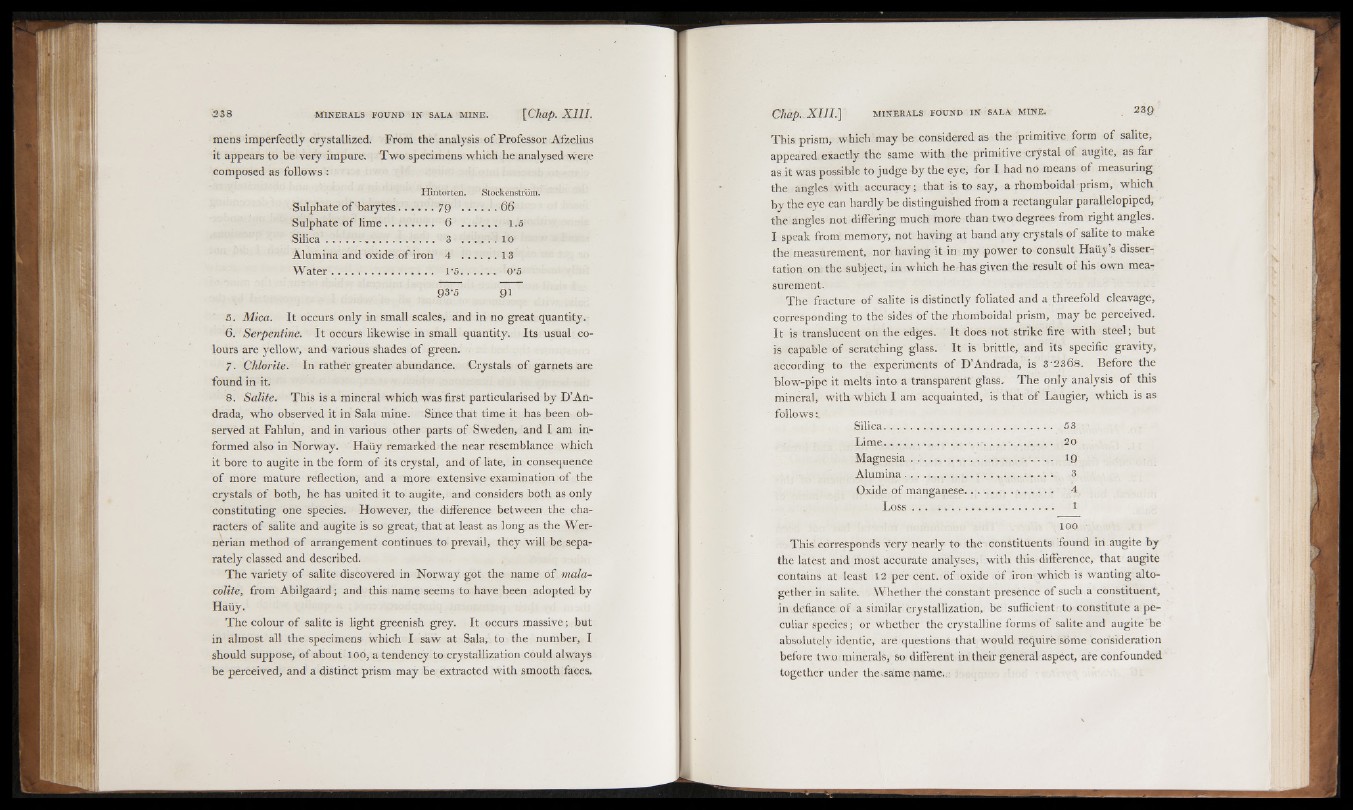
mens imperfectly crystallized. From the analysis of Professor Afzelius
it appears to be very impure. Two specimens which he analysed were
composed as follows :
flint orten. Stockenstrom.
Sulphate of barytes 79 ......... . 66
Sulphate of lime 6 ............ 1.5
Silica .................... 3 . . . . . . lo
Alumina and oxide of iron 4 .............13
Water ...................... 1 *5. . . . . . 0*5
93'5 9 1
' 5 . Mica. It occurs only in small scales, and in no great quantity.
6 . Serpentine. It occurs likewise in small quantity. Its usual colours
are yellow, and various shades o f green.
7 . Chlorite. In rathe'r greater abundance. Crystals o f garnets are
found in it.
8. Salite. This is a mineral which was first particularised by D’An-
drada, who observed it in Sala mine. Since that time it has been observed
at Fahlun, and in various other parts of Sweden, and I am informed
also in Norway. Haiiy remarked the near resemblance which
it bore to augite in the form of its crystal, and of late, in consequence
of more mature reflection, and a more extensive examination of the
crystals o f both, he has united it to augite, and considers both as only
constituting one species. However, the difference between the characters
o f salite and augite is so great, that at least as long as the Wernerian
method of arrangement continues to. prevail, they will be separately
classed and described.
The variety of salite discovered in Norway got the name of mala-
colite, from Abilgaard; and this name seems to have been adopted by
Haiiy.
The colour of salite is light greenish grey. It occurs massive; but
in almost all the specimens which I saw at Sala, to the number, I
should suppose, of about loo, a tendency to crystallization could always
be perceived, and a distinct prism may be extracted with smooth faces.
This prism, which may be considered as the primitive form o f salite,
appeared exactly thé same with the primitive crystal of augite, as far
as it was possible to judge by the eye, for I had no means o f measuring
the angles with accuracy ; that is to say, a rhomboidal prism, which
by the eye can hardly be distinguished from a rectangular parallelopiped,
the angles not differing much more than two degrees from right angles.
I speak from memory, not having at hand any crystals o f salite to make
the measurement, nor having it in my power to consult Haüy’s dissertation
on. the subject, in which he has given the result of his own measurement.
The fracture of salite is distinctly foliated and a threefold cleavage,
corresponding to the sides of the rhomboidal prism, may be perceived.
It is translucent on the edges. It does not strike fire with steel; but
is capable of scratching glass. It is brittle, and its specific gravity,
according to the experiments of D’Andrada, is 3 *2368. Before the
blow-pipe it melts into a transparent glass. The only analysis of this
mineral, with which I am acquainted, is that o f Laugier, which is as
follows I
Silica....................................................... 53
Lime,. ......... . . . . . . 20
Magnesia ................. 19
Alumina . . . ........... 3
Oxide of manganese. ........... .4
Loss ......................... I
100
This corresponds very nearly to the constituents found in augite by
the latest and most accurate analyses, with this difference, that augite
contains at least 12 per cent, of oxide of iron which is wanting altogether
in salite. Whether the constant presènce óf such a constituent,
in defiance; of a similar crystallization, be sufficient to constitute a peculiar
species; or whether the crystalline forms o f salite and augite be
absolutely identic, are questions that would require some consideration
before two minerals, so different in their general aspect, are confounded
together under the-same name. ■